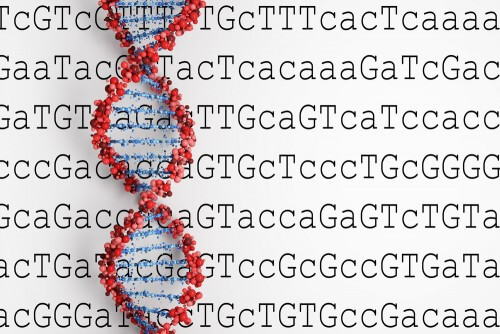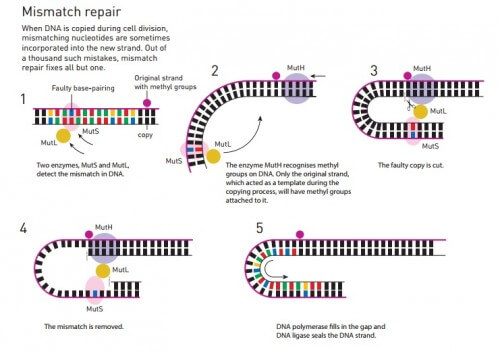Paul Modritz discovered that apart from the mechanisms of 'base excision repair', 'nucleotide excision repair' and 'mispair repair', there are several other mechanisms that protect our DNA and malfunctions in them often cause cancer

11 Researcher Paul Modritz grew up in a small town in the north of the state of New Mexico in the USA. The versatility and the abundance of types of landscapes made him interested in nature, but one day his father, a biology teacher, told him: "You should learn about this subject, DNA." It was in 1963, just one year after James Watson and Francis Crick won the Nobel Prize for discovering the structure of DNA.
After a few years, the topic of DNA really became a central part of Paul Modritz's life. Early in his research career, as a doctoral student at Stanford University, as a post-doctoral student at Harvard University, and as a professor at Duke University, he examined a series of enzymes that affect DNA: DNA ligase, DNA polymerase, and the restriction enzyme Eco RI.. Then, in the late seventies when he focused on the Dam methylase enzyme, he encountered another part of the DNA field, the part that would be a significant part of his scientific career.
Weaving together two areas of research
The enzyme dam methylase attaches methyl groups to DNA. Paul Modritz showed that these methyl groups may function as signaling markers that help a specified restriction enzyme to cut the DNA helix at the desired location. At the same time, only a few years earlier, the researcher Matthew Michelson, a molecular biologist from Harvard University, proposed a different signaling mechanism for the methyl groups on the DNA.
With the help of molecular biology tools, the researcher Matthew Michelson created a virus in which several bases were inserted in the wrong positions in the DNA. For example, he could have substituted the base cytosine for thymine. When he allowed these viruses to infect bacteria, the bacteria corrected these errors. No one knew why the bacteria developed this ability, but in 1976 Miselson hypothesized that it might be a repair mechanism for DNA during its replication. If this is indeed the case, then perhaps the methyl groups on the DNA help the bacteria identify the segment that will serve as a template for repair.
At this point, in the DNA methylation process, the research paths of the two researchers met. While working together, they created a virus that contained several splicing errors in its DNA. In this case, the enzyme discovered by Modritz was also used to add methyl groups to one of the DNA coils. When these viruses infected bacteria, the bacteria were consistently able to repair the DNA helix that lacked methyl groups. The conclusion of the two researchers was that the mechanism of 'wrong pairing repair' in DNA is a natural process that corrects base pairing errors in DNA during its replication, while locating the wrong helix that does not include the methyl groups.
Paul Modritz - Demonstration of the mechanism of 'mispair repair' in DNA
For Paul Modritz, this discovery initiated a decade of systematic research into cloning and mapping enzymes related to the repair mechanism. Towards the end of the 1989s, he managed to reproduce the complex repair mechanism in vitro and study it in great detail. The findings of this study were published in XNUMX.
Paul Modritz, just like Thomas Lindahl and Aziz Sanger, also studied the human equivalent of this repair mechanism. We now know that 999 out of every thousand errors during the replication of the human genome are corrected by the mechanism of mispair repair. At the same time, as part of the repair mechanism in human DNA, we still do not know how the original helix is identified. The DNA methylation mechanism has other roles in the human genome beyond those that exist in bacteria, and therefore there must also be something else that controls the selection of the helix that undergoes repair - and this question has not yet been resolved.
Defects in the repair mechanisms cause cancer
Apart from the mechanisms of 'base excision repair', 'nucleotide excision repair' and 'mispair repair', there are several other mechanisms that protect our DNA. Every day, these mechanisms repair thousands of DNA damages caused by exposure to the sun, cigarette smoke or other carcinogens; Without these repair mechanisms our genome would completely collapse. If only one of the components were to fail, the genetic information would change rapidly and the likelihood of developing cancer would increase. A congenital defect in the repair mechanism causes a number of diseases, including the disease 'xeroderma pigmentosum', whose patients are particularly sensitive to ultraviolet radiation and develop skin cancer after exposure to the sun. In addition, defects in the repair mechanisms increase the risk of developing hereditary colon cancer.
In fact, in many types of cancer, it turns out that one or more of these repair mechanisms is defective, partially or completely. This result makes the DNA of the cancer cells unstable, which is one of the reasons why cancer cells often undergo mutations and become resistant to chemotherapy treatments. At the same time, these diseased cells are even more dependent on the repair mechanisms, which are still active in the body; In their absence, their DNA will be too damaged and the cell itself will die. Researchers are trying to exploit this weakness in the development of new drugs against cancer. Inhibiting the remaining repair mechanisms allows researchers to slow down and even completely stop the growth of the tumor. One example of a drug that inhibits the repair mechanism in cancer is Olaparib (Wikipedia).
In conclusion, the fundamental research carried out by the 2015 Nobel Laureates in Chemistry has not only increased our knowledge about how we work, but it may also lead to the development of life-saving treatments.

Correcting a wrong coupling - explanation for the picture
When the DNA is replicated during cell division, sometimes nucleotides are placed in the wrong positions in the new helix. Out of 1000 such errors, this mechanism corrects 999 of them.
Step 1 - Incorrect base pairing. Two enzymes, MutS and MutL, locate the error in the DNA.
Step 2 - the MutH enzyme detects methyl groups on the DNA. Only the original helix, which serves as a template during replication, will have methyl groups attached to it.
Step 3 – The damaged copy is cut.
Step 4 – The error is removed.
Step 5 - The polymerase enzyme completes the gap created as a result of the cut and the DNA ligase enzyme seals the DNA helix.
Previous episodes in the series
- Thomas Lindahl, one of the winners of the 2015 Nobel Prize in Chemistry: "Life exists - therefore DNA must be repairable" (part 1)
- Nobel Prize in Chemistry 2015 - Part 2: "Biochemistry is the attending physician of life"
- Nobel Prize in Chemistry for discoverers of DNA repair mechanisms (The initial news about the win)
